Healthcare Industry: Big Data Opportunities and Value Creation Report
VerifiedAdded on 2023/01/05
|12
|3336
|89
Report
AI Summary
This report examines the transformative impact of Big Data within the healthcare industry. It begins with an executive summary outlining the key drivers: unstructured, structured, and low-latency data, alongside predictive analytics. It then explores the opportunities arising from Big Data, such as cost reduction, service innovation, and personalized medicine. The report includes a value chain analysis of a specific healthcare organization in Australia, demonstrating Big Data's ability to improve both primary and secondary activities. Furthermore, Porter's Five Forces analysis is employed to assess how Big Data technologies can help companies navigate a changing business environment. The report's structure covers an introduction, business drivers, Big Data opportunities, value creation, value chain analysis, Porter's five forces, and a conclusion, providing a comprehensive overview of the subject.
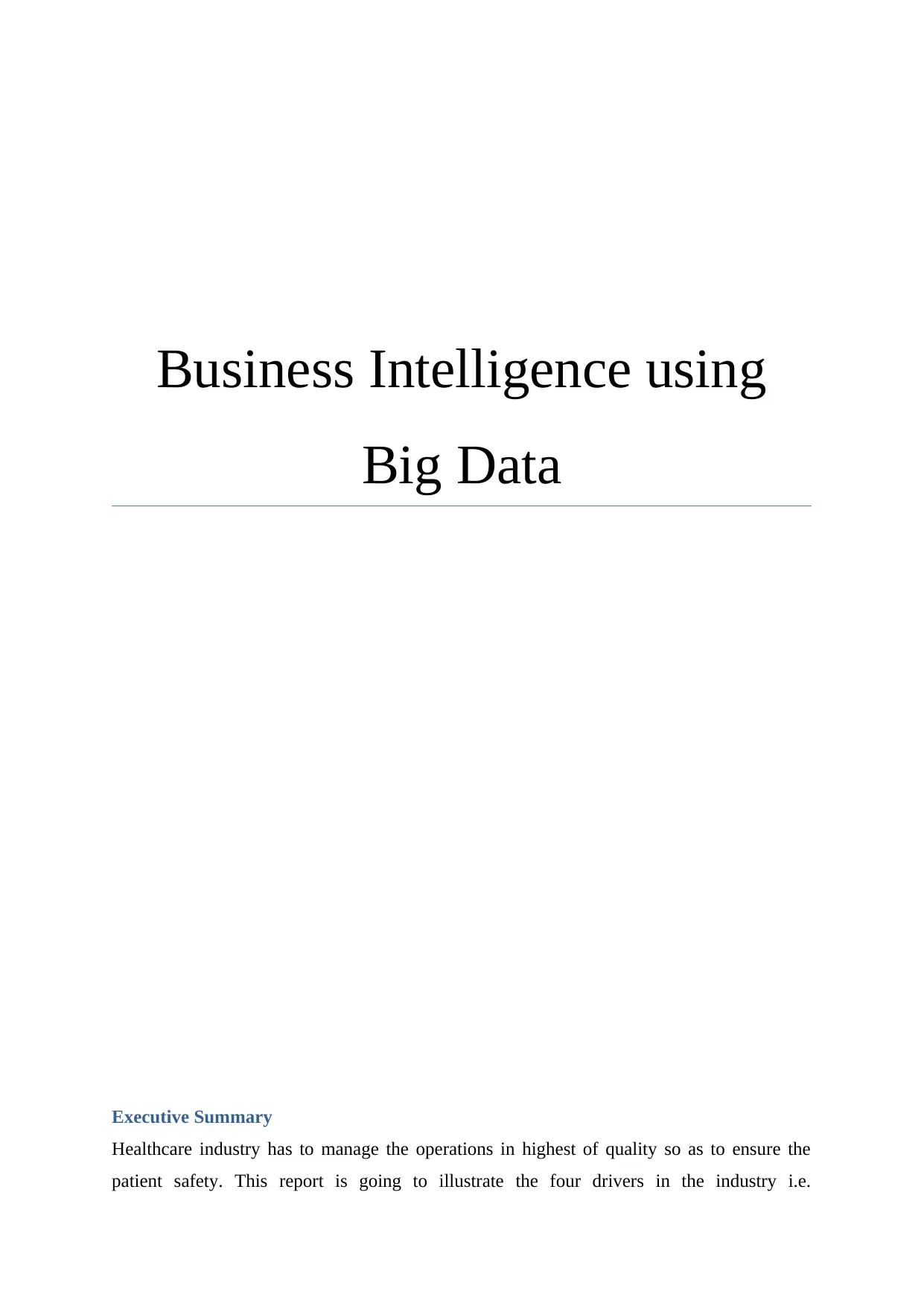
Business Intelligence using
Big Data
Executive Summary
Healthcare industry has to manage the operations in highest of quality so as to ensure the
patient safety. This report is going to illustrate the four drivers in the industry i.e.
Big Data
Executive Summary
Healthcare industry has to manage the operations in highest of quality so as to ensure the
patient safety. This report is going to illustrate the four drivers in the industry i.e.
Paraphrase This Document
Need a fresh take? Get an instant paraphrase of this document with our AI Paraphraser
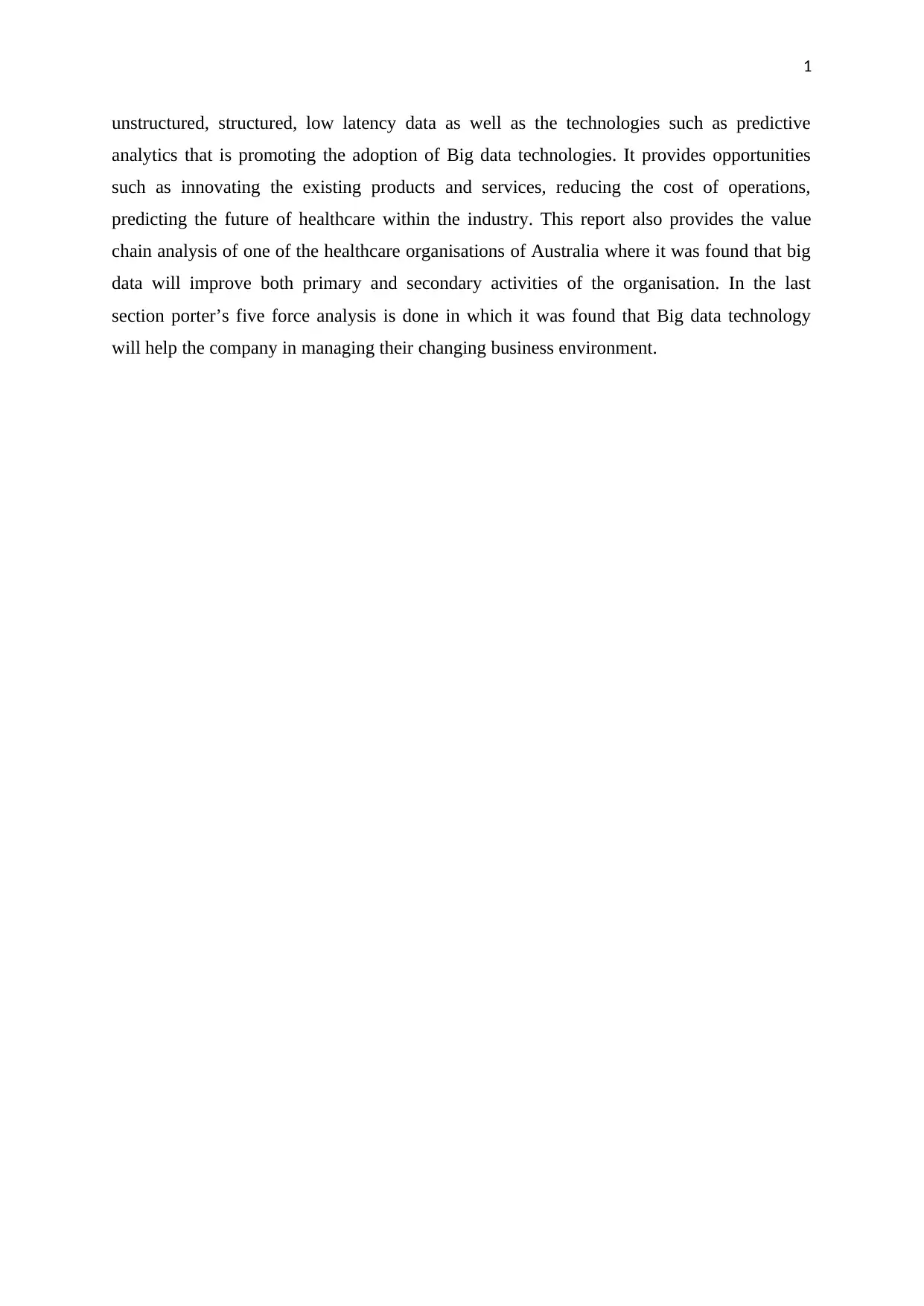
1
unstructured, structured, low latency data as well as the technologies such as predictive
analytics that is promoting the adoption of Big data technologies. It provides opportunities
such as innovating the existing products and services, reducing the cost of operations,
predicting the future of healthcare within the industry. This report also provides the value
chain analysis of one of the healthcare organisations of Australia where it was found that big
data will improve both primary and secondary activities of the organisation. In the last
section porter’s five force analysis is done in which it was found that Big data technology
will help the company in managing their changing business environment.
unstructured, structured, low latency data as well as the technologies such as predictive
analytics that is promoting the adoption of Big data technologies. It provides opportunities
such as innovating the existing products and services, reducing the cost of operations,
predicting the future of healthcare within the industry. This report also provides the value
chain analysis of one of the healthcare organisations of Australia where it was found that big
data will improve both primary and secondary activities of the organisation. In the last
section porter’s five force analysis is done in which it was found that Big data technology
will help the company in managing their changing business environment.
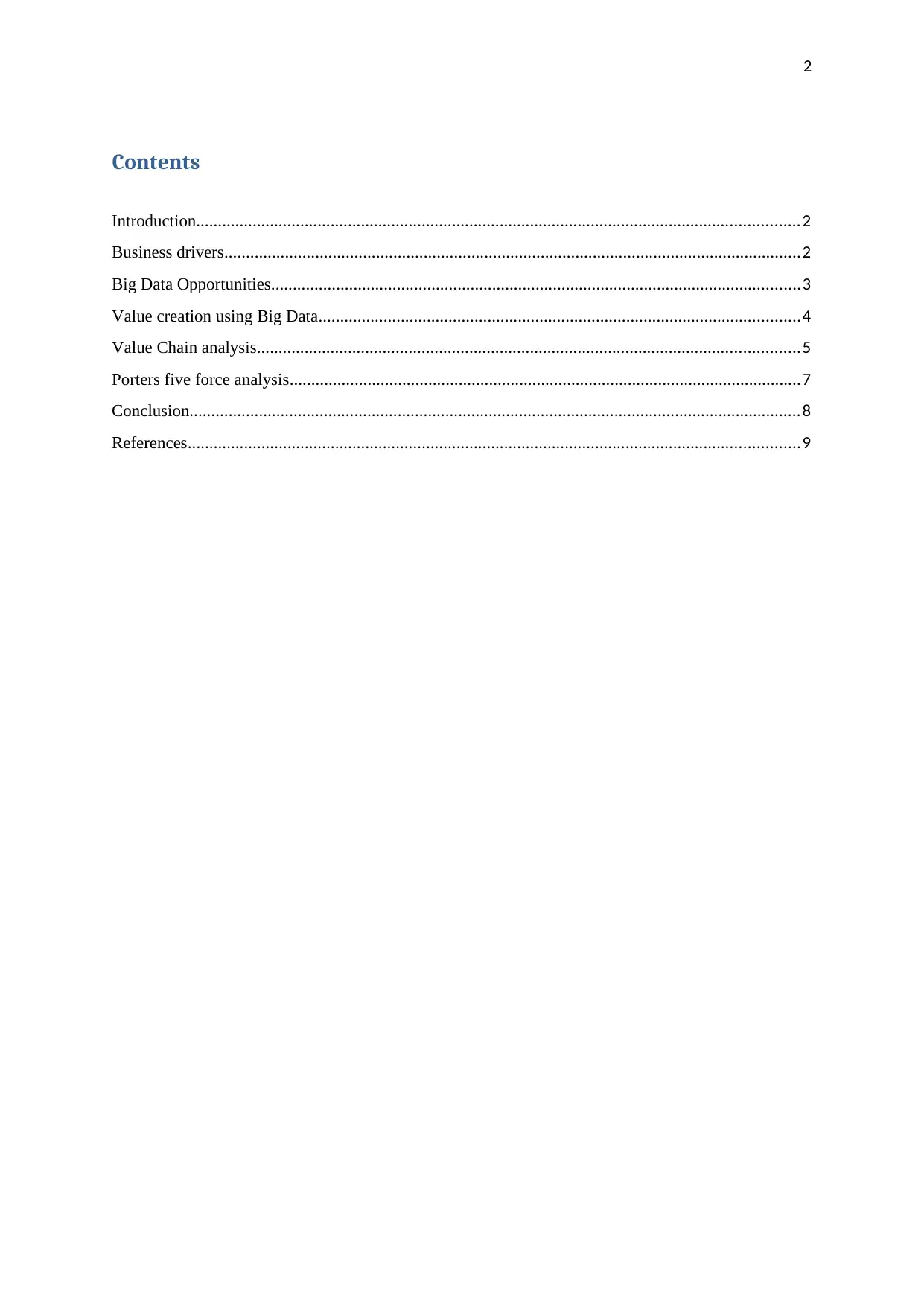
2
Contents
Introduction...........................................................................................................................................2
Business drivers.....................................................................................................................................2
Big Data Opportunities..........................................................................................................................3
Value creation using Big Data...............................................................................................................4
Value Chain analysis.............................................................................................................................5
Porters five force analysis......................................................................................................................7
Conclusion.............................................................................................................................................8
References.............................................................................................................................................9
Contents
Introduction...........................................................................................................................................2
Business drivers.....................................................................................................................................2
Big Data Opportunities..........................................................................................................................3
Value creation using Big Data...............................................................................................................4
Value Chain analysis.............................................................................................................................5
Porters five force analysis......................................................................................................................7
Conclusion.............................................................................................................................................8
References.............................................................................................................................................9
⊘ This is a preview!⊘
Do you want full access?
Subscribe today to unlock all pages.

Trusted by 1+ million students worldwide
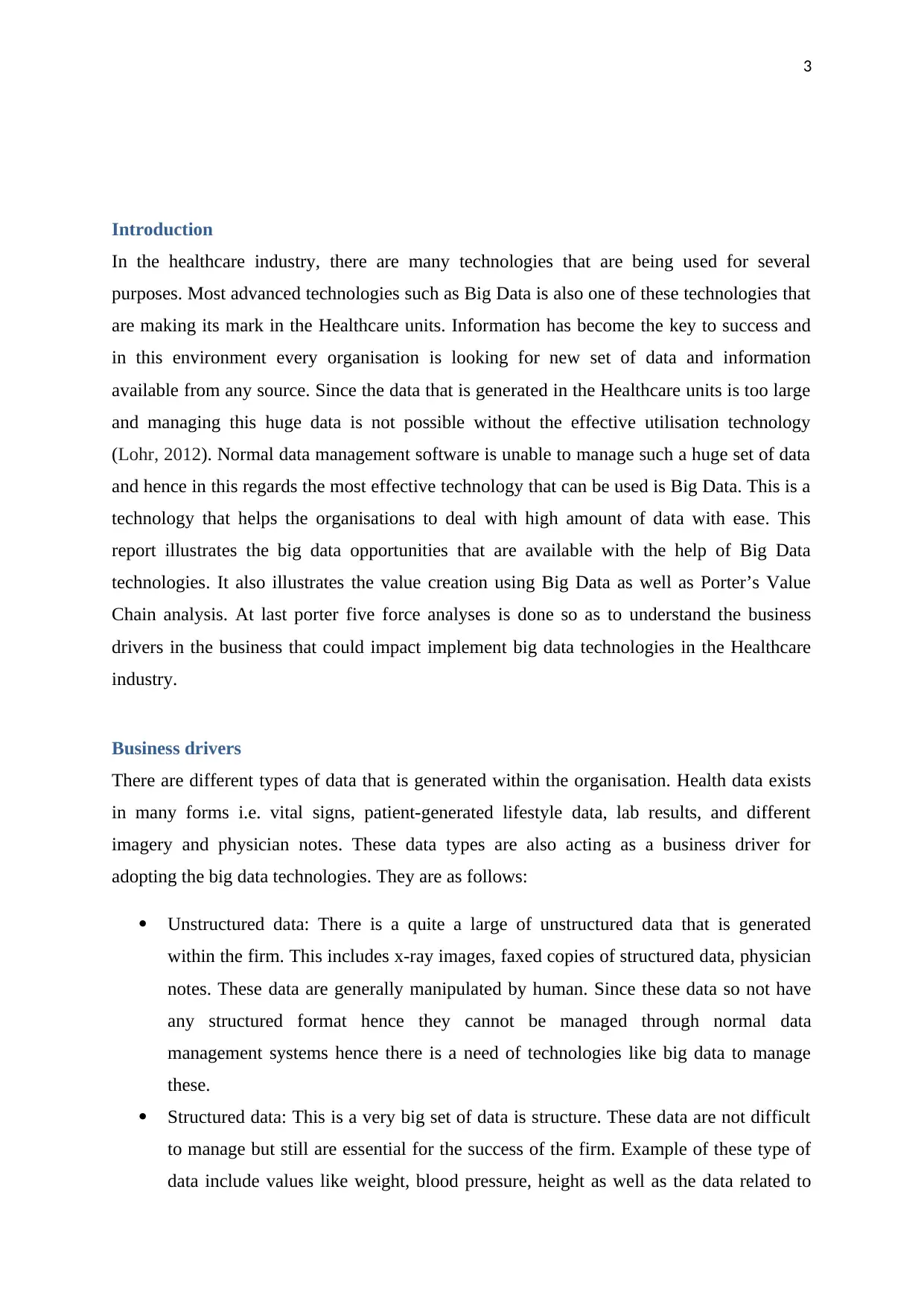
3
Introduction
In the healthcare industry, there are many technologies that are being used for several
purposes. Most advanced technologies such as Big Data is also one of these technologies that
are making its mark in the Healthcare units. Information has become the key to success and
in this environment every organisation is looking for new set of data and information
available from any source. Since the data that is generated in the Healthcare units is too large
and managing this huge data is not possible without the effective utilisation technology
(Lohr, 2012). Normal data management software is unable to manage such a huge set of data
and hence in this regards the most effective technology that can be used is Big Data. This is a
technology that helps the organisations to deal with high amount of data with ease. This
report illustrates the big data opportunities that are available with the help of Big Data
technologies. It also illustrates the value creation using Big Data as well as Porter’s Value
Chain analysis. At last porter five force analyses is done so as to understand the business
drivers in the business that could impact implement big data technologies in the Healthcare
industry.
Business drivers
There are different types of data that is generated within the organisation. Health data exists
in many forms i.e. vital signs, patient-generated lifestyle data, lab results, and different
imagery and physician notes. These data types are also acting as a business driver for
adopting the big data technologies. They are as follows:
Unstructured data: There is a quite a large of unstructured data that is generated
within the firm. This includes x-ray images, faxed copies of structured data, physician
notes. These data are generally manipulated by human. Since these data so not have
any structured format hence they cannot be managed through normal data
management systems hence there is a need of technologies like big data to manage
these.
Structured data: This is a very big set of data is structure. These data are not difficult
to manage but still are essential for the success of the firm. Example of these type of
data include values like weight, blood pressure, height as well as the data related to
Introduction
In the healthcare industry, there are many technologies that are being used for several
purposes. Most advanced technologies such as Big Data is also one of these technologies that
are making its mark in the Healthcare units. Information has become the key to success and
in this environment every organisation is looking for new set of data and information
available from any source. Since the data that is generated in the Healthcare units is too large
and managing this huge data is not possible without the effective utilisation technology
(Lohr, 2012). Normal data management software is unable to manage such a huge set of data
and hence in this regards the most effective technology that can be used is Big Data. This is a
technology that helps the organisations to deal with high amount of data with ease. This
report illustrates the big data opportunities that are available with the help of Big Data
technologies. It also illustrates the value creation using Big Data as well as Porter’s Value
Chain analysis. At last porter five force analyses is done so as to understand the business
drivers in the business that could impact implement big data technologies in the Healthcare
industry.
Business drivers
There are different types of data that is generated within the organisation. Health data exists
in many forms i.e. vital signs, patient-generated lifestyle data, lab results, and different
imagery and physician notes. These data types are also acting as a business driver for
adopting the big data technologies. They are as follows:
Unstructured data: There is a quite a large of unstructured data that is generated
within the firm. This includes x-ray images, faxed copies of structured data, physician
notes. These data are generally manipulated by human. Since these data so not have
any structured format hence they cannot be managed through normal data
management systems hence there is a need of technologies like big data to manage
these.
Structured data: This is a very big set of data is structure. These data are not difficult
to manage but still are essential for the success of the firm. Example of these type of
data include values like weight, blood pressure, height as well as the data related to
Paraphrase This Document
Need a fresh take? Get an instant paraphrase of this document with our AI Paraphraser
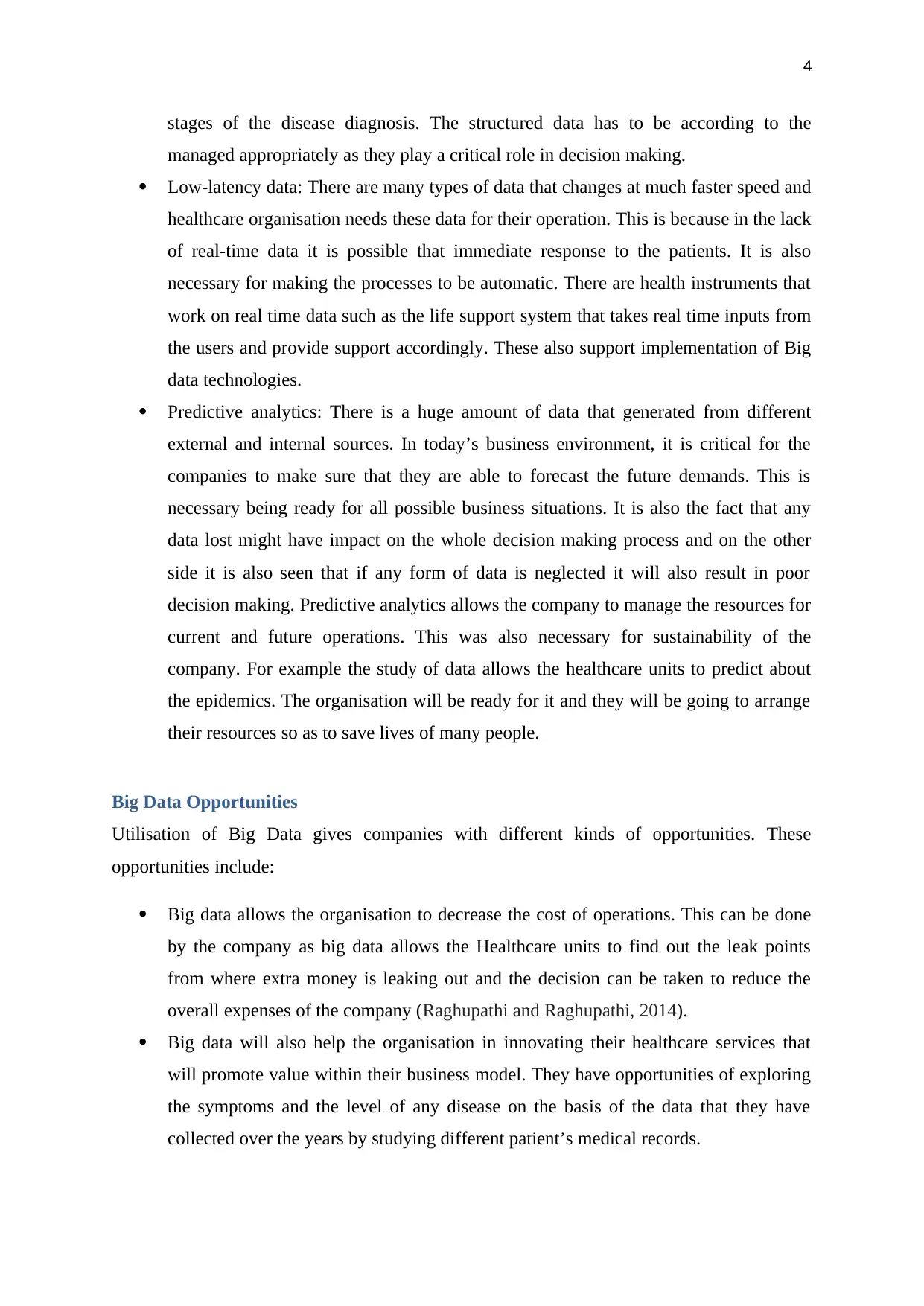
4
stages of the disease diagnosis. The structured data has to be according to the
managed appropriately as they play a critical role in decision making.
Low-latency data: There are many types of data that changes at much faster speed and
healthcare organisation needs these data for their operation. This is because in the lack
of real-time data it is possible that immediate response to the patients. It is also
necessary for making the processes to be automatic. There are health instruments that
work on real time data such as the life support system that takes real time inputs from
the users and provide support accordingly. These also support implementation of Big
data technologies.
Predictive analytics: There is a huge amount of data that generated from different
external and internal sources. In today’s business environment, it is critical for the
companies to make sure that they are able to forecast the future demands. This is
necessary being ready for all possible business situations. It is also the fact that any
data lost might have impact on the whole decision making process and on the other
side it is also seen that if any form of data is neglected it will also result in poor
decision making. Predictive analytics allows the company to manage the resources for
current and future operations. This was also necessary for sustainability of the
company. For example the study of data allows the healthcare units to predict about
the epidemics. The organisation will be ready for it and they will be going to arrange
their resources so as to save lives of many people.
Big Data Opportunities
Utilisation of Big Data gives companies with different kinds of opportunities. These
opportunities include:
Big data allows the organisation to decrease the cost of operations. This can be done
by the company as big data allows the Healthcare units to find out the leak points
from where extra money is leaking out and the decision can be taken to reduce the
overall expenses of the company (Raghupathi and Raghupathi, 2014).
Big data will also help the organisation in innovating their healthcare services that
will promote value within their business model. They have opportunities of exploring
the symptoms and the level of any disease on the basis of the data that they have
collected over the years by studying different patient’s medical records.
stages of the disease diagnosis. The structured data has to be according to the
managed appropriately as they play a critical role in decision making.
Low-latency data: There are many types of data that changes at much faster speed and
healthcare organisation needs these data for their operation. This is because in the lack
of real-time data it is possible that immediate response to the patients. It is also
necessary for making the processes to be automatic. There are health instruments that
work on real time data such as the life support system that takes real time inputs from
the users and provide support accordingly. These also support implementation of Big
data technologies.
Predictive analytics: There is a huge amount of data that generated from different
external and internal sources. In today’s business environment, it is critical for the
companies to make sure that they are able to forecast the future demands. This is
necessary being ready for all possible business situations. It is also the fact that any
data lost might have impact on the whole decision making process and on the other
side it is also seen that if any form of data is neglected it will also result in poor
decision making. Predictive analytics allows the company to manage the resources for
current and future operations. This was also necessary for sustainability of the
company. For example the study of data allows the healthcare units to predict about
the epidemics. The organisation will be ready for it and they will be going to arrange
their resources so as to save lives of many people.
Big Data Opportunities
Utilisation of Big Data gives companies with different kinds of opportunities. These
opportunities include:
Big data allows the organisation to decrease the cost of operations. This can be done
by the company as big data allows the Healthcare units to find out the leak points
from where extra money is leaking out and the decision can be taken to reduce the
overall expenses of the company (Raghupathi and Raghupathi, 2014).
Big data will also help the organisation in innovating their healthcare services that
will promote value within their business model. They have opportunities of exploring
the symptoms and the level of any disease on the basis of the data that they have
collected over the years by studying different patient’s medical records.
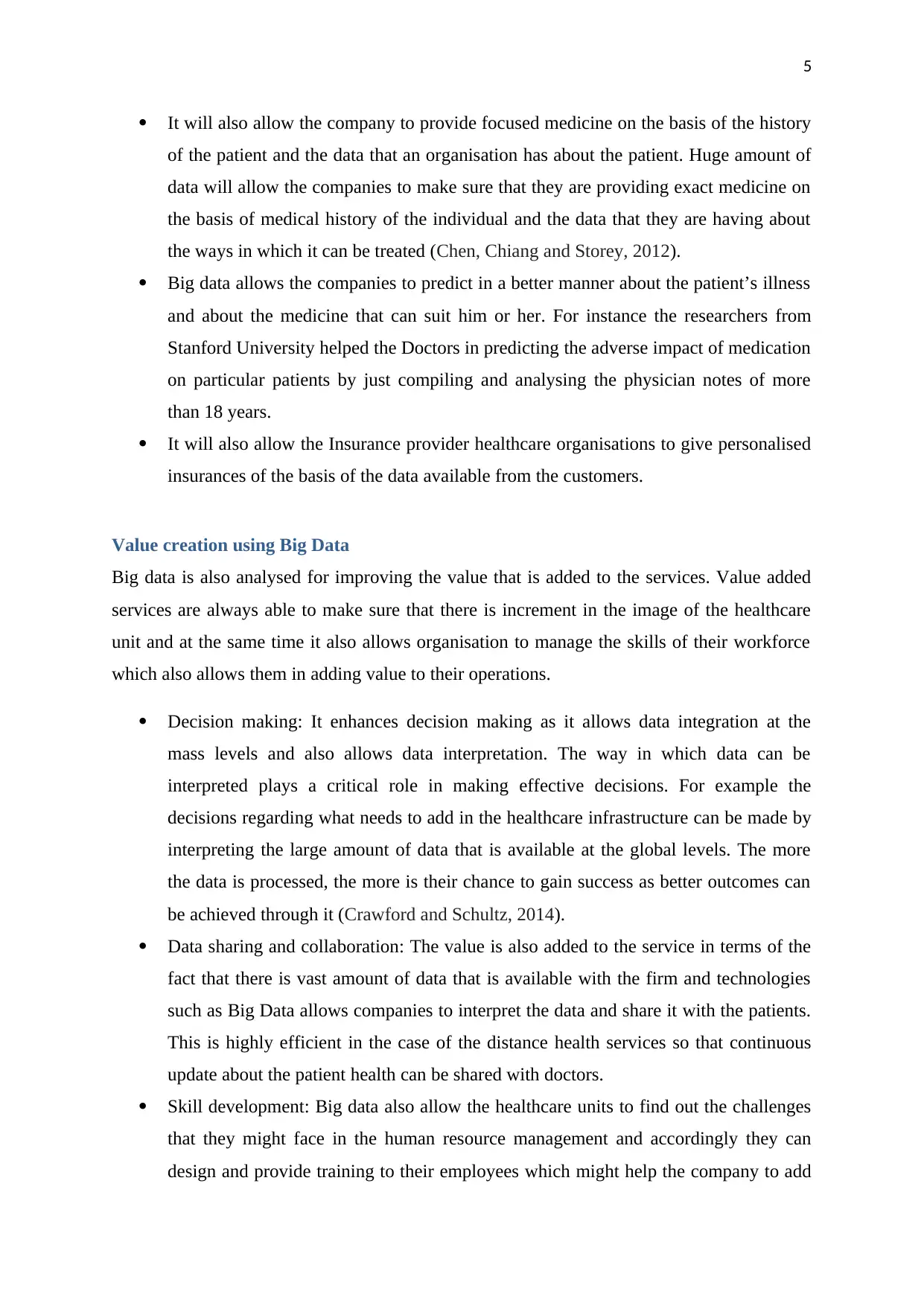
5
It will also allow the company to provide focused medicine on the basis of the history
of the patient and the data that an organisation has about the patient. Huge amount of
data will allow the companies to make sure that they are providing exact medicine on
the basis of medical history of the individual and the data that they are having about
the ways in which it can be treated (Chen, Chiang and Storey, 2012).
Big data allows the companies to predict in a better manner about the patient’s illness
and about the medicine that can suit him or her. For instance the researchers from
Stanford University helped the Doctors in predicting the adverse impact of medication
on particular patients by just compiling and analysing the physician notes of more
than 18 years.
It will also allow the Insurance provider healthcare organisations to give personalised
insurances of the basis of the data available from the customers.
Value creation using Big Data
Big data is also analysed for improving the value that is added to the services. Value added
services are always able to make sure that there is increment in the image of the healthcare
unit and at the same time it also allows organisation to manage the skills of their workforce
which also allows them in adding value to their operations.
Decision making: It enhances decision making as it allows data integration at the
mass levels and also allows data interpretation. The way in which data can be
interpreted plays a critical role in making effective decisions. For example the
decisions regarding what needs to add in the healthcare infrastructure can be made by
interpreting the large amount of data that is available at the global levels. The more
the data is processed, the more is their chance to gain success as better outcomes can
be achieved through it (Crawford and Schultz, 2014).
Data sharing and collaboration: The value is also added to the service in terms of the
fact that there is vast amount of data that is available with the firm and technologies
such as Big Data allows companies to interpret the data and share it with the patients.
This is highly efficient in the case of the distance health services so that continuous
update about the patient health can be shared with doctors.
Skill development: Big data also allow the healthcare units to find out the challenges
that they might face in the human resource management and accordingly they can
design and provide training to their employees which might help the company to add
It will also allow the company to provide focused medicine on the basis of the history
of the patient and the data that an organisation has about the patient. Huge amount of
data will allow the companies to make sure that they are providing exact medicine on
the basis of medical history of the individual and the data that they are having about
the ways in which it can be treated (Chen, Chiang and Storey, 2012).
Big data allows the companies to predict in a better manner about the patient’s illness
and about the medicine that can suit him or her. For instance the researchers from
Stanford University helped the Doctors in predicting the adverse impact of medication
on particular patients by just compiling and analysing the physician notes of more
than 18 years.
It will also allow the Insurance provider healthcare organisations to give personalised
insurances of the basis of the data available from the customers.
Value creation using Big Data
Big data is also analysed for improving the value that is added to the services. Value added
services are always able to make sure that there is increment in the image of the healthcare
unit and at the same time it also allows organisation to manage the skills of their workforce
which also allows them in adding value to their operations.
Decision making: It enhances decision making as it allows data integration at the
mass levels and also allows data interpretation. The way in which data can be
interpreted plays a critical role in making effective decisions. For example the
decisions regarding what needs to add in the healthcare infrastructure can be made by
interpreting the large amount of data that is available at the global levels. The more
the data is processed, the more is their chance to gain success as better outcomes can
be achieved through it (Crawford and Schultz, 2014).
Data sharing and collaboration: The value is also added to the service in terms of the
fact that there is vast amount of data that is available with the firm and technologies
such as Big Data allows companies to interpret the data and share it with the patients.
This is highly efficient in the case of the distance health services so that continuous
update about the patient health can be shared with doctors.
Skill development: Big data also allow the healthcare units to find out the challenges
that they might face in the human resource management and accordingly they can
design and provide training to their employees which might help the company to add
⊘ This is a preview!⊘
Do you want full access?
Subscribe today to unlock all pages.

Trusted by 1+ million students worldwide
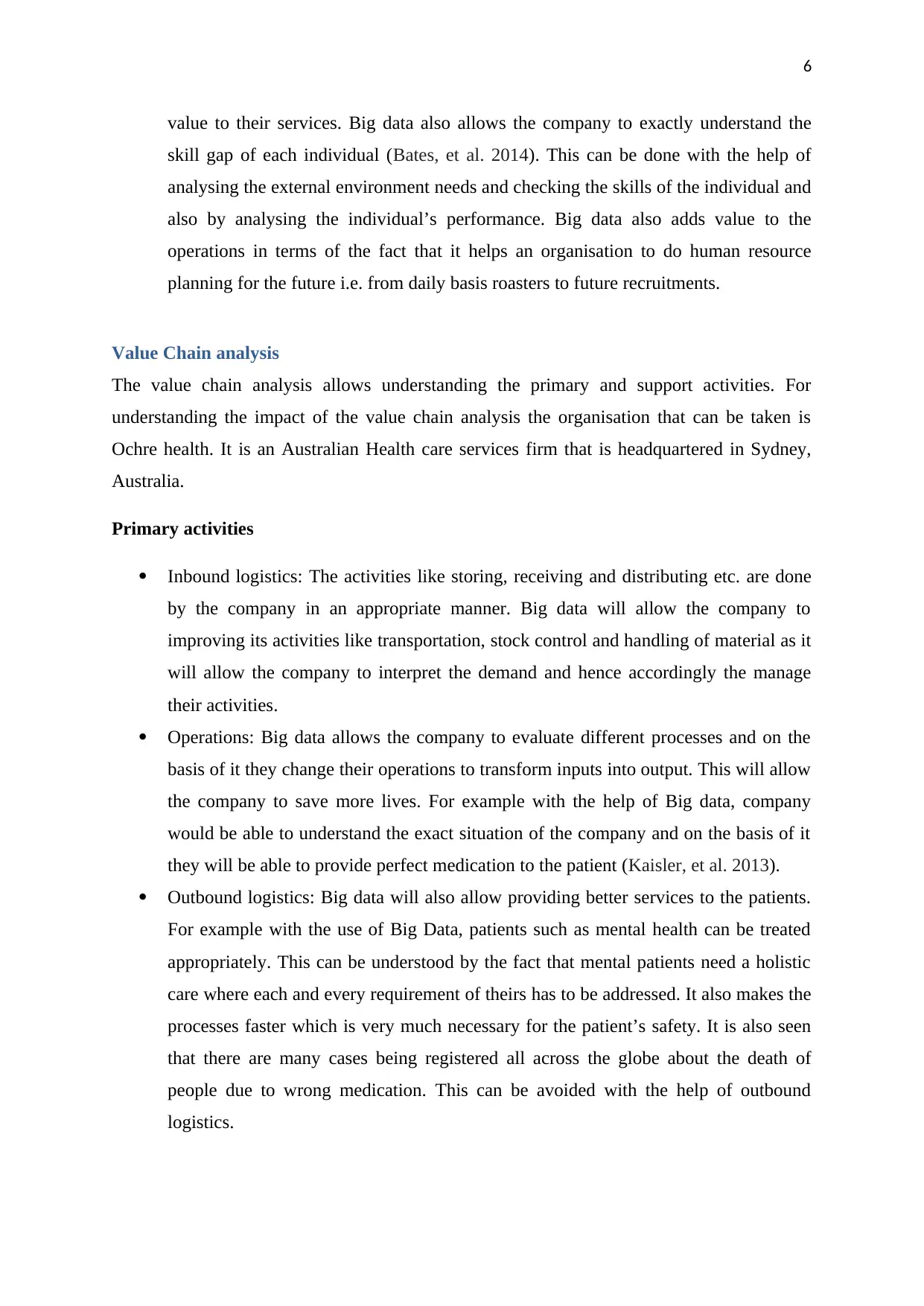
6
value to their services. Big data also allows the company to exactly understand the
skill gap of each individual (Bates, et al. 2014). This can be done with the help of
analysing the external environment needs and checking the skills of the individual and
also by analysing the individual’s performance. Big data also adds value to the
operations in terms of the fact that it helps an organisation to do human resource
planning for the future i.e. from daily basis roasters to future recruitments.
Value Chain analysis
The value chain analysis allows understanding the primary and support activities. For
understanding the impact of the value chain analysis the organisation that can be taken is
Ochre health. It is an Australian Health care services firm that is headquartered in Sydney,
Australia.
Primary activities
Inbound logistics: The activities like storing, receiving and distributing etc. are done
by the company in an appropriate manner. Big data will allow the company to
improving its activities like transportation, stock control and handling of material as it
will allow the company to interpret the demand and hence accordingly the manage
their activities.
Operations: Big data allows the company to evaluate different processes and on the
basis of it they change their operations to transform inputs into output. This will allow
the company to save more lives. For example with the help of Big data, company
would be able to understand the exact situation of the company and on the basis of it
they will be able to provide perfect medication to the patient (Kaisler, et al. 2013).
Outbound logistics: Big data will also allow providing better services to the patients.
For example with the use of Big Data, patients such as mental health can be treated
appropriately. This can be understood by the fact that mental patients need a holistic
care where each and every requirement of theirs has to be addressed. It also makes the
processes faster which is very much necessary for the patient’s safety. It is also seen
that there are many cases being registered all across the globe about the death of
people due to wrong medication. This can be avoided with the help of outbound
logistics.
value to their services. Big data also allows the company to exactly understand the
skill gap of each individual (Bates, et al. 2014). This can be done with the help of
analysing the external environment needs and checking the skills of the individual and
also by analysing the individual’s performance. Big data also adds value to the
operations in terms of the fact that it helps an organisation to do human resource
planning for the future i.e. from daily basis roasters to future recruitments.
Value Chain analysis
The value chain analysis allows understanding the primary and support activities. For
understanding the impact of the value chain analysis the organisation that can be taken is
Ochre health. It is an Australian Health care services firm that is headquartered in Sydney,
Australia.
Primary activities
Inbound logistics: The activities like storing, receiving and distributing etc. are done
by the company in an appropriate manner. Big data will allow the company to
improving its activities like transportation, stock control and handling of material as it
will allow the company to interpret the demand and hence accordingly the manage
their activities.
Operations: Big data allows the company to evaluate different processes and on the
basis of it they change their operations to transform inputs into output. This will allow
the company to save more lives. For example with the help of Big data, company
would be able to understand the exact situation of the company and on the basis of it
they will be able to provide perfect medication to the patient (Kaisler, et al. 2013).
Outbound logistics: Big data will also allow providing better services to the patients.
For example with the use of Big Data, patients such as mental health can be treated
appropriately. This can be understood by the fact that mental patients need a holistic
care where each and every requirement of theirs has to be addressed. It also makes the
processes faster which is very much necessary for the patient’s safety. It is also seen
that there are many cases being registered all across the globe about the death of
people due to wrong medication. This can be avoided with the help of outbound
logistics.
Paraphrase This Document
Need a fresh take? Get an instant paraphrase of this document with our AI Paraphraser
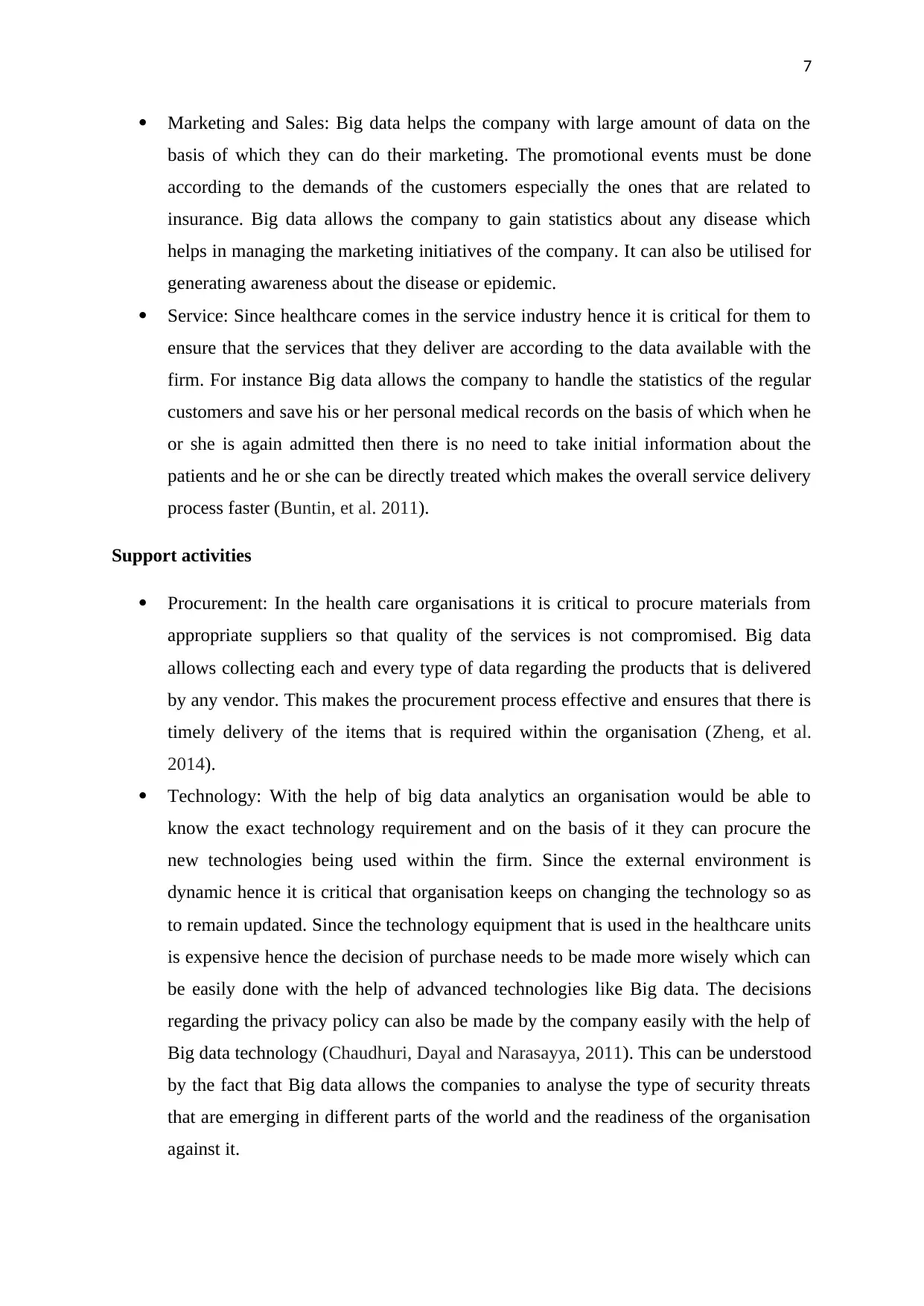
7
Marketing and Sales: Big data helps the company with large amount of data on the
basis of which they can do their marketing. The promotional events must be done
according to the demands of the customers especially the ones that are related to
insurance. Big data allows the company to gain statistics about any disease which
helps in managing the marketing initiatives of the company. It can also be utilised for
generating awareness about the disease or epidemic.
Service: Since healthcare comes in the service industry hence it is critical for them to
ensure that the services that they deliver are according to the data available with the
firm. For instance Big data allows the company to handle the statistics of the regular
customers and save his or her personal medical records on the basis of which when he
or she is again admitted then there is no need to take initial information about the
patients and he or she can be directly treated which makes the overall service delivery
process faster (Buntin, et al. 2011).
Support activities
Procurement: In the health care organisations it is critical to procure materials from
appropriate suppliers so that quality of the services is not compromised. Big data
allows collecting each and every type of data regarding the products that is delivered
by any vendor. This makes the procurement process effective and ensures that there is
timely delivery of the items that is required within the organisation (Zheng, et al.
2014).
Technology: With the help of big data analytics an organisation would be able to
know the exact technology requirement and on the basis of it they can procure the
new technologies being used within the firm. Since the external environment is
dynamic hence it is critical that organisation keeps on changing the technology so as
to remain updated. Since the technology equipment that is used in the healthcare units
is expensive hence the decision of purchase needs to be made more wisely which can
be easily done with the help of advanced technologies like Big data. The decisions
regarding the privacy policy can also be made by the company easily with the help of
Big data technology (Chaudhuri, Dayal and Narasayya, 2011). This can be understood
by the fact that Big data allows the companies to analyse the type of security threats
that are emerging in different parts of the world and the readiness of the organisation
against it.
Marketing and Sales: Big data helps the company with large amount of data on the
basis of which they can do their marketing. The promotional events must be done
according to the demands of the customers especially the ones that are related to
insurance. Big data allows the company to gain statistics about any disease which
helps in managing the marketing initiatives of the company. It can also be utilised for
generating awareness about the disease or epidemic.
Service: Since healthcare comes in the service industry hence it is critical for them to
ensure that the services that they deliver are according to the data available with the
firm. For instance Big data allows the company to handle the statistics of the regular
customers and save his or her personal medical records on the basis of which when he
or she is again admitted then there is no need to take initial information about the
patients and he or she can be directly treated which makes the overall service delivery
process faster (Buntin, et al. 2011).
Support activities
Procurement: In the health care organisations it is critical to procure materials from
appropriate suppliers so that quality of the services is not compromised. Big data
allows collecting each and every type of data regarding the products that is delivered
by any vendor. This makes the procurement process effective and ensures that there is
timely delivery of the items that is required within the organisation (Zheng, et al.
2014).
Technology: With the help of big data analytics an organisation would be able to
know the exact technology requirement and on the basis of it they can procure the
new technologies being used within the firm. Since the external environment is
dynamic hence it is critical that organisation keeps on changing the technology so as
to remain updated. Since the technology equipment that is used in the healthcare units
is expensive hence the decision of purchase needs to be made more wisely which can
be easily done with the help of advanced technologies like Big data. The decisions
regarding the privacy policy can also be made by the company easily with the help of
Big data technology (Chaudhuri, Dayal and Narasayya, 2011). This can be understood
by the fact that Big data allows the companies to analyse the type of security threats
that are emerging in different parts of the world and the readiness of the organisation
against it.
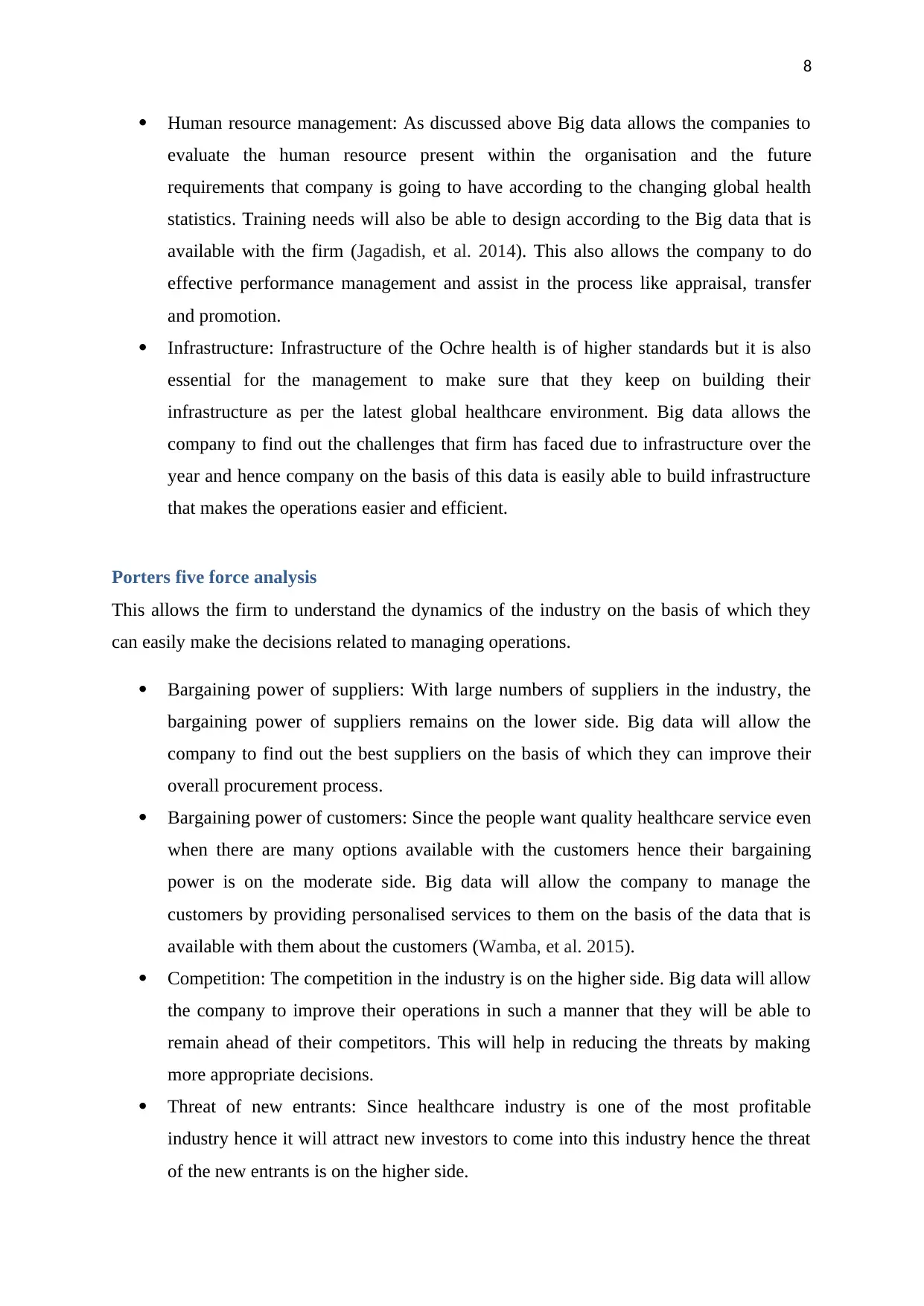
8
Human resource management: As discussed above Big data allows the companies to
evaluate the human resource present within the organisation and the future
requirements that company is going to have according to the changing global health
statistics. Training needs will also be able to design according to the Big data that is
available with the firm (Jagadish, et al. 2014). This also allows the company to do
effective performance management and assist in the process like appraisal, transfer
and promotion.
Infrastructure: Infrastructure of the Ochre health is of higher standards but it is also
essential for the management to make sure that they keep on building their
infrastructure as per the latest global healthcare environment. Big data allows the
company to find out the challenges that firm has faced due to infrastructure over the
year and hence company on the basis of this data is easily able to build infrastructure
that makes the operations easier and efficient.
Porters five force analysis
This allows the firm to understand the dynamics of the industry on the basis of which they
can easily make the decisions related to managing operations.
Bargaining power of suppliers: With large numbers of suppliers in the industry, the
bargaining power of suppliers remains on the lower side. Big data will allow the
company to find out the best suppliers on the basis of which they can improve their
overall procurement process.
Bargaining power of customers: Since the people want quality healthcare service even
when there are many options available with the customers hence their bargaining
power is on the moderate side. Big data will allow the company to manage the
customers by providing personalised services to them on the basis of the data that is
available with them about the customers (Wamba, et al. 2015).
Competition: The competition in the industry is on the higher side. Big data will allow
the company to improve their operations in such a manner that they will be able to
remain ahead of their competitors. This will help in reducing the threats by making
more appropriate decisions.
Threat of new entrants: Since healthcare industry is one of the most profitable
industry hence it will attract new investors to come into this industry hence the threat
of the new entrants is on the higher side.
Human resource management: As discussed above Big data allows the companies to
evaluate the human resource present within the organisation and the future
requirements that company is going to have according to the changing global health
statistics. Training needs will also be able to design according to the Big data that is
available with the firm (Jagadish, et al. 2014). This also allows the company to do
effective performance management and assist in the process like appraisal, transfer
and promotion.
Infrastructure: Infrastructure of the Ochre health is of higher standards but it is also
essential for the management to make sure that they keep on building their
infrastructure as per the latest global healthcare environment. Big data allows the
company to find out the challenges that firm has faced due to infrastructure over the
year and hence company on the basis of this data is easily able to build infrastructure
that makes the operations easier and efficient.
Porters five force analysis
This allows the firm to understand the dynamics of the industry on the basis of which they
can easily make the decisions related to managing operations.
Bargaining power of suppliers: With large numbers of suppliers in the industry, the
bargaining power of suppliers remains on the lower side. Big data will allow the
company to find out the best suppliers on the basis of which they can improve their
overall procurement process.
Bargaining power of customers: Since the people want quality healthcare service even
when there are many options available with the customers hence their bargaining
power is on the moderate side. Big data will allow the company to manage the
customers by providing personalised services to them on the basis of the data that is
available with them about the customers (Wamba, et al. 2015).
Competition: The competition in the industry is on the higher side. Big data will allow
the company to improve their operations in such a manner that they will be able to
remain ahead of their competitors. This will help in reducing the threats by making
more appropriate decisions.
Threat of new entrants: Since healthcare industry is one of the most profitable
industry hence it will attract new investors to come into this industry hence the threat
of the new entrants is on the higher side.
⊘ This is a preview!⊘
Do you want full access?
Subscribe today to unlock all pages.

Trusted by 1+ million students worldwide
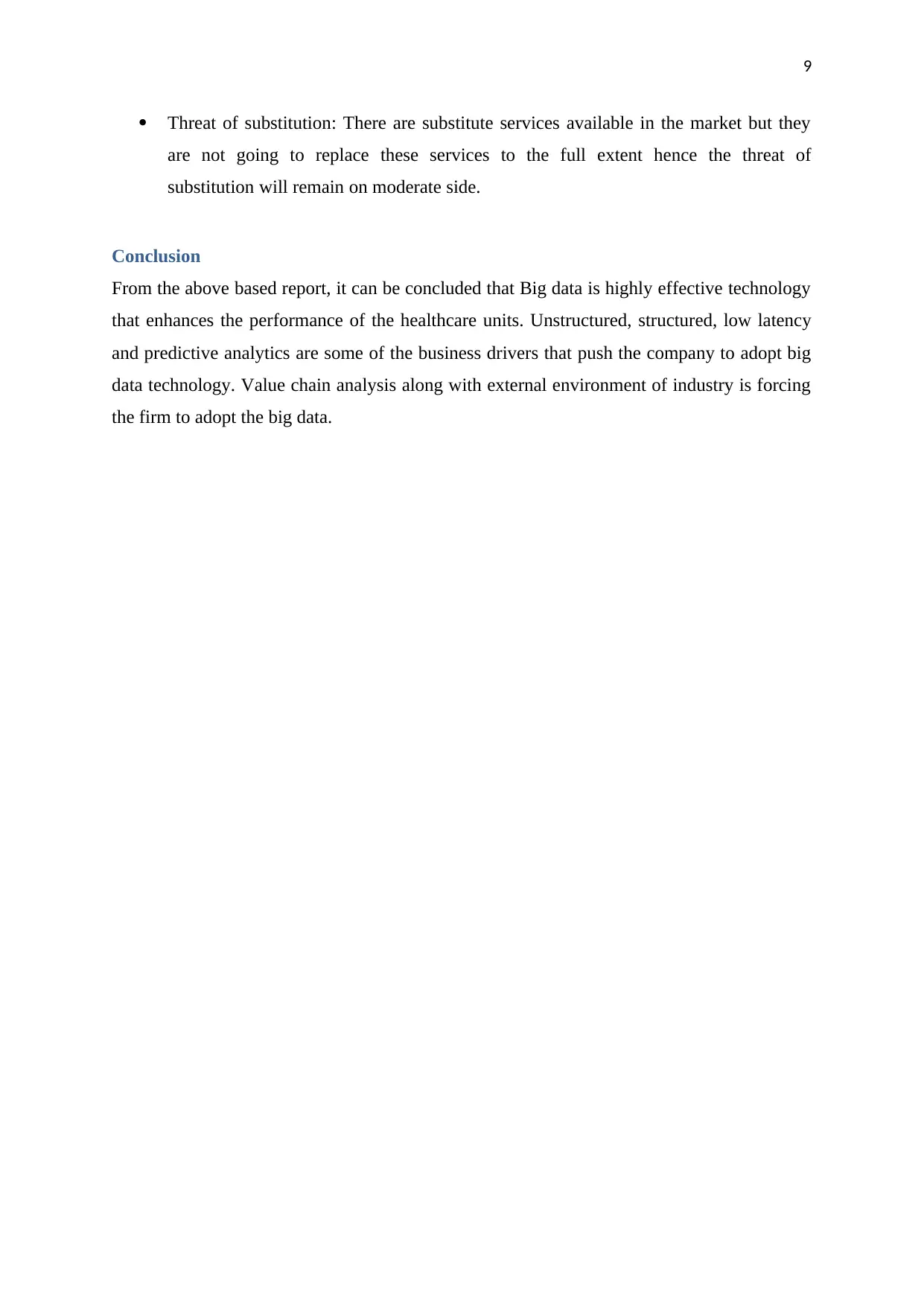
9
Threat of substitution: There are substitute services available in the market but they
are not going to replace these services to the full extent hence the threat of
substitution will remain on moderate side.
Conclusion
From the above based report, it can be concluded that Big data is highly effective technology
that enhances the performance of the healthcare units. Unstructured, structured, low latency
and predictive analytics are some of the business drivers that push the company to adopt big
data technology. Value chain analysis along with external environment of industry is forcing
the firm to adopt the big data.
Threat of substitution: There are substitute services available in the market but they
are not going to replace these services to the full extent hence the threat of
substitution will remain on moderate side.
Conclusion
From the above based report, it can be concluded that Big data is highly effective technology
that enhances the performance of the healthcare units. Unstructured, structured, low latency
and predictive analytics are some of the business drivers that push the company to adopt big
data technology. Value chain analysis along with external environment of industry is forcing
the firm to adopt the big data.
Paraphrase This Document
Need a fresh take? Get an instant paraphrase of this document with our AI Paraphraser
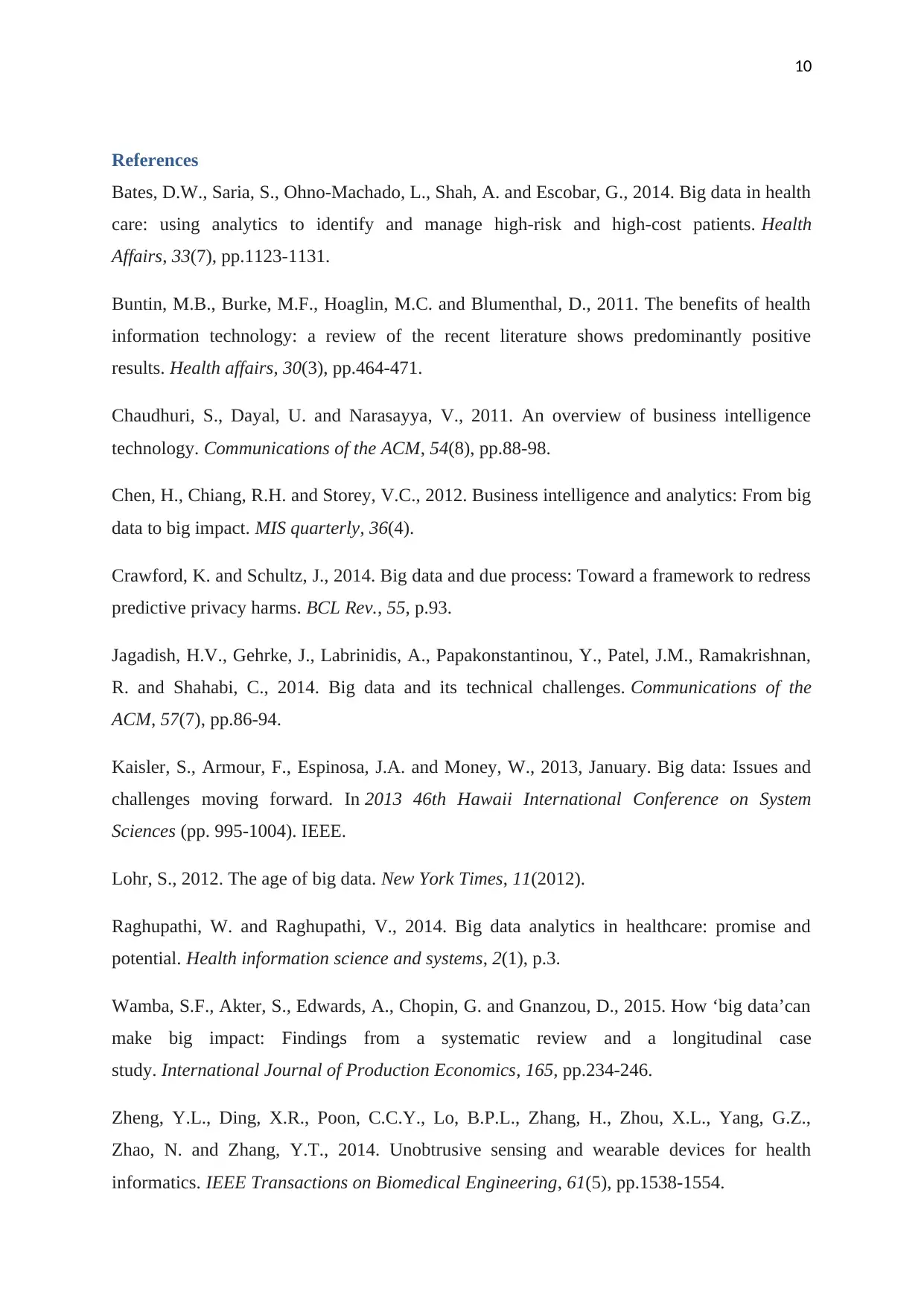
10
References
Bates, D.W., Saria, S., Ohno-Machado, L., Shah, A. and Escobar, G., 2014. Big data in health
care: using analytics to identify and manage high-risk and high-cost patients. Health
Affairs, 33(7), pp.1123-1131.
Buntin, M.B., Burke, M.F., Hoaglin, M.C. and Blumenthal, D., 2011. The benefits of health
information technology: a review of the recent literature shows predominantly positive
results. Health affairs, 30(3), pp.464-471.
Chaudhuri, S., Dayal, U. and Narasayya, V., 2011. An overview of business intelligence
technology. Communications of the ACM, 54(8), pp.88-98.
Chen, H., Chiang, R.H. and Storey, V.C., 2012. Business intelligence and analytics: From big
data to big impact. MIS quarterly, 36(4).
Crawford, K. and Schultz, J., 2014. Big data and due process: Toward a framework to redress
predictive privacy harms. BCL Rev., 55, p.93.
Jagadish, H.V., Gehrke, J., Labrinidis, A., Papakonstantinou, Y., Patel, J.M., Ramakrishnan,
R. and Shahabi, C., 2014. Big data and its technical challenges. Communications of the
ACM, 57(7), pp.86-94.
Kaisler, S., Armour, F., Espinosa, J.A. and Money, W., 2013, January. Big data: Issues and
challenges moving forward. In 2013 46th Hawaii International Conference on System
Sciences (pp. 995-1004). IEEE.
Lohr, S., 2012. The age of big data. New York Times, 11(2012).
Raghupathi, W. and Raghupathi, V., 2014. Big data analytics in healthcare: promise and
potential. Health information science and systems, 2(1), p.3.
Wamba, S.F., Akter, S., Edwards, A., Chopin, G. and Gnanzou, D., 2015. How ‘big data’can
make big impact: Findings from a systematic review and a longitudinal case
study. International Journal of Production Economics, 165, pp.234-246.
Zheng, Y.L., Ding, X.R., Poon, C.C.Y., Lo, B.P.L., Zhang, H., Zhou, X.L., Yang, G.Z.,
Zhao, N. and Zhang, Y.T., 2014. Unobtrusive sensing and wearable devices for health
informatics. IEEE Transactions on Biomedical Engineering, 61(5), pp.1538-1554.
References
Bates, D.W., Saria, S., Ohno-Machado, L., Shah, A. and Escobar, G., 2014. Big data in health
care: using analytics to identify and manage high-risk and high-cost patients. Health
Affairs, 33(7), pp.1123-1131.
Buntin, M.B., Burke, M.F., Hoaglin, M.C. and Blumenthal, D., 2011. The benefits of health
information technology: a review of the recent literature shows predominantly positive
results. Health affairs, 30(3), pp.464-471.
Chaudhuri, S., Dayal, U. and Narasayya, V., 2011. An overview of business intelligence
technology. Communications of the ACM, 54(8), pp.88-98.
Chen, H., Chiang, R.H. and Storey, V.C., 2012. Business intelligence and analytics: From big
data to big impact. MIS quarterly, 36(4).
Crawford, K. and Schultz, J., 2014. Big data and due process: Toward a framework to redress
predictive privacy harms. BCL Rev., 55, p.93.
Jagadish, H.V., Gehrke, J., Labrinidis, A., Papakonstantinou, Y., Patel, J.M., Ramakrishnan,
R. and Shahabi, C., 2014. Big data and its technical challenges. Communications of the
ACM, 57(7), pp.86-94.
Kaisler, S., Armour, F., Espinosa, J.A. and Money, W., 2013, January. Big data: Issues and
challenges moving forward. In 2013 46th Hawaii International Conference on System
Sciences (pp. 995-1004). IEEE.
Lohr, S., 2012. The age of big data. New York Times, 11(2012).
Raghupathi, W. and Raghupathi, V., 2014. Big data analytics in healthcare: promise and
potential. Health information science and systems, 2(1), p.3.
Wamba, S.F., Akter, S., Edwards, A., Chopin, G. and Gnanzou, D., 2015. How ‘big data’can
make big impact: Findings from a systematic review and a longitudinal case
study. International Journal of Production Economics, 165, pp.234-246.
Zheng, Y.L., Ding, X.R., Poon, C.C.Y., Lo, B.P.L., Zhang, H., Zhou, X.L., Yang, G.Z.,
Zhao, N. and Zhang, Y.T., 2014. Unobtrusive sensing and wearable devices for health
informatics. IEEE Transactions on Biomedical Engineering, 61(5), pp.1538-1554.

11
⊘ This is a preview!⊘
Do you want full access?
Subscribe today to unlock all pages.

Trusted by 1+ million students worldwide
1 out of 12
Related Documents
Your All-in-One AI-Powered Toolkit for Academic Success.
+13062052269
info@desklib.com
Available 24*7 on WhatsApp / Email
![[object Object]](/_next/static/media/star-bottom.7253800d.svg)
Unlock your academic potential
Copyright © 2020–2025 A2Z Services. All Rights Reserved. Developed and managed by ZUCOL.





